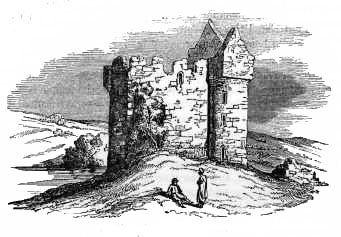Plantation of Ulster
There can be little doubt, from Sir Henry Docwra's own account, that O'Dogherty was purposely insulted, and goaded into rebellion. He was the last obstacle to the grand scheme, and he was disposed of. Ulster was now at the mercy of those who chose to accept grants of land; and the grants were made to the highest bidders, or to those who had paid for the favour by previous services. Sir Arthur Chichester evidently considered that he belonged to the latter class, for we find him writing [6] at considerable length to the Earl of Northampton, then a ruling member of King James' cabinet, to request that he may be appointed President of Ulster. He commences his epistle by stating how deeply he is indebted to his Lordship for his comfortable and kind letters, and the praise he has given him in public and private. He then bestows an abundant meed of commendation on his justice in return.
He next explains his hopes and desires. He declares that he wishes for the Presidency of Ulster, "more for the service he might there do his Majesty, than for the profit he expects,"—a statement which the Earl no doubt read exactly as it was intended; and he says that he only mentions his case because "charitie beginnes with myeselfe," which, indeed, appears to have been the view of that virtue generally taken by all planters and adventurers. He concludes with delicately informing his correspondent, that if he can advance any friend of his in any way he will be most happy to do so. This letter is dated from the "Castle of Dublin, 7th of February, 1607." The date should read, according to the change of style, 1608. The Lord Deputy knew well what he was asking for. During the summer of the preceding year, he had made a careful journey through Ulster, with Sir John Davies; and Carte has well observed, that "nobody knew the territories better to be planted;" and he might have added, that few persons had a clearer eye to their own advantage in the arrangements he made.

Castle Monea, County Fermanagh
The plan of the plantation was agreed upon in 1609. It was the old plan which had been attempted before, though with less show of legal arrangement, but with quite the same proportion of legal iniquity. The simple object was to expel the natives, and to extirpate the Catholic religion. The six counties to be planted were Tyrone, Derry, Donegal, Armagh, Fermanagh, and Cavan. These were parcelled out into portions varying from 2,000 to 4,000 acres, and the planters were obliged to build bawns and castles, such as that of Castle Monea, county Fermanagh, of which we subjoin an illustration. Tully Castle [7] was built by Sir John Hume, on his plantation. Both these castles afford good examples of the structures erected at this period. The great desiderata were proximity to water and rising ground—the beauty of the surrounding scenery, which was superadded at least at Tully Castle, was probably but little valued.
Notes
[6] Writing.—The original is in the Cot. Col. British Museum.
[7] Tully Castle.—See heading of this chapter.
